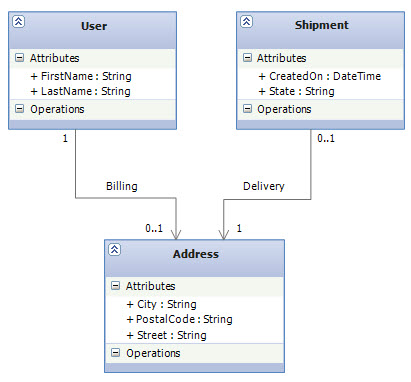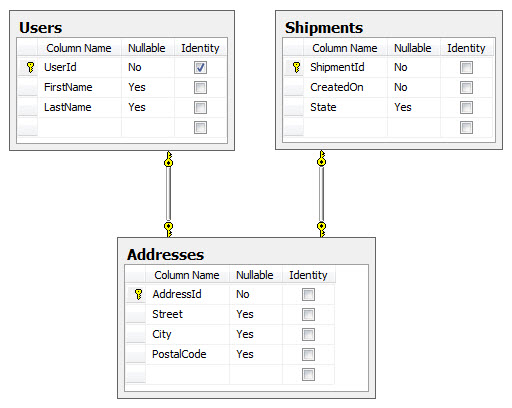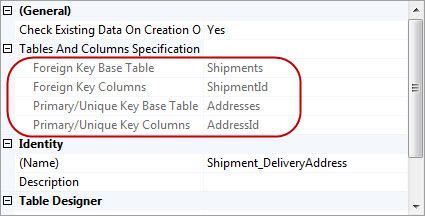Associations in EF Code First CTP5: Part 2 – Shared Primary Key Associations
| In the previous blog post I demonstrated how to map a special kind of one-to-one association—a composition with complex types as the first post in a series about entity association mapping with EF Code First. We argued that the relationships between User and Address are best represented with a complex type mapping and we saw that this is usually the simplest way to represent one-to-one relationships but comes with some limitations. In today’s blog post I’m going to discuss how we can address those limitations by changing our mapping strategy. This is particularly useful for scenarios that we want a dedicated table for Address, so that we can map both User and Address as entities. One benefit of this model is the possibility for shared references— another entity class (let’s say Shipment) can also have a reference to a particular Address instance. If a User has a reference to this instance, as her BillingAddress, the Address instance has to support shared references and needs its own identity. In this case, User and Address classes have a true one-to-one association. Introducing the Revised ModelIn this revised version, each User could have one BillingAddress (Billing Association). Also Shipment has to be delivered to an address so it always has one Delivery Address (Delivery Association). Here is the class diagram for this domain model (note the multiplicities on association lines): |
 |
In this model we assumed that the billing address of the user is the same as her delivery address. Now let’s create the association mappings for this domain model. There are several choices, the first being a One-to-One Primary Key Association.
Shared Primary AssociationsAlso know as One-to-One Primary Key Associations, means two related tables share the same primary key values. The primary key of one table is also a foreign key of the other. Let’s see how we map the primary key associations with Code First.How to Implement a One-to-One Primary Key Association with Code FirstFirst, we start with the POCO classes. As you can see, we've defined BillingAddress as a navigation property on User class and another one on Shipment class named DeliveryAddress. Both associations are unidirectional since we didn't define related navigation properties on Address class as for User and Shipment. |
public class User { public int UserId { get; set; } public string FirstName { get; set; } public string LastName { get; set; } public virtual Address BillingAddress { get; set; } } public class Address { public int AddressId { get; set; } public string Street { get; set; } public string City { get; set; } public string PostalCode { get; set; } } public class Shipment { public int ShipmentId { get; set; } public DateTime CreatedOn { get; set; } public string State { get; set; } public virtual Address DeliveryAddress { get; set; } } public class EntityMappingContext : DbContext { public DbSet<User> Users { get; set; } public DbSet<Address> Addresses { get; set; } public DbSet<Shipment> Shipments { get; set; } } |
How Code First Reads This Object Model: One-to-ManyCode First reads the model and tries to figure out the multiplicity of the associations. Since the associations are unidirectional, Code First takes this as if one Address has many Users and Many Shipments and will create a one-to-many association for each of them. So, what we were hoping for —a one-to-one association, is not inline with the conventions.How to Change the Multiplicity to One-to-One by Using the ConventionsOne way to turn our associations to be one-to-one is by making them bidirectional. That is, adding a new navigation property to Address class of type User and another one of type Shipment. By doing that we basically signal Code First that we are looking to have one-to-one associations since for example User has an Address and also Address has a User. Based on the conventions, Code First will change the multiplicity to one-to-one and this will solve the problem.Should We Make This Association Bidirectional?As always, the decision is up to us and depends on whether we need to navigate through our objects in that direction in the application code. In this case, we’d probably conclude that the bidirectional association doesn’t make much sense. If we call anAddress.User, we are saying “give me the user who has this address”, not a very reasonable request. So this is not a good option. Instead we'll keep our object model as it is and will resort to fluent API.How to Change the Multiplicity to One-to-One with Fluent APIThe following code is all that is needed to make the associations to be one-to-one. Note how the multiplicities in the UML class diagram (e.g. 1 on User and 0..1 on address) has been translated to the flunet API code by using HasRequired and HasOptional methods: |
protected override void OnModelCreating(ModelBuilder modelBuilder) { modelBuilder.Entity<User>().HasOptional(u => u.BillingAddress) .WithRequired(); modelBuilder.Entity<Shipment>().HasRequired(u => u.DeliveryAddress) .WithOptional(); } |
| Also it worth mentioning that in CTP5, when we are mapping a one-to-one association with fluent API, we don't need to specify the foreign key as we would do when mapping a one-to-many association with HasForeignKey method. Since EF only supports one-to-one primary key associations it will automatically create the relationship in the database based on the primary keys and we don't need to state the obvious as we did in CTP4. |
Database SchemaThe mapping result for our object model is as follows (note the Identity column): |
 |
Referential IntegrityIn relational database design the referential integrity rule states that each non-null value of a foreign key must match the value of some primary key. But wait, how does it even applies here? All we have is just three primary keys referencing each other. Who is the primary key and who is the foreign key? The best way to find the answer of this question is to take a look at the properties of the relationships in the database that has been created by Code First: |
 |
 |
As you can see, Code First adds a foreign key constraint which links the primary key of the Addresses table to the primary key of the Users table and adds another foreign key constraint that links the primary key of the Shipments table to the primary key of the Addresses table. The foreign key constraint means that a user has to exist for a particular address but not the other way around. In other words, the database guarantees that an Addresses row’s primary key references a valid Users primary key and a Shipments row’s primary key references a valid Addresses primary key.
How Code First Determines Principal and Dependent?Code First has rules to determine the principal and dependent ends of an association. For one-to-many relationships the many end is always the dependent, but it gets a little tricky in one-to-one associations. In one-to-one associations Code First decides based on our object model, and possible data annotations or fluent API that we may have. For example in our case, we wrote this fluent API code to configure User-Address association: |
modelBuilder.Entity<User>().HasOptional(u => u.BillingAddress).WithRequired(); |
| This reads as "User entity has an optional association with one Address object but this association is required for Address entity." For Code First this is good enough to make the decision: It marked User as the principal end and Address as the dependent end in the association. Since we have the same fluent API code for the second association between Address and Shipment, it marks Address as the principal end and Shipment as the dependent end in this association as well. The referential integrity that we saw, is the first result of this Code First's principal/dependent decision. Second Result of Code First's Principal/Dependent Decision: Database IdentityIf you take a closer look at the above DB schema, you'll notice that only UserId has a regular identifier generator (aka Identity or Sequence) and AddressId and ShipmentId does not. This is a very important consequence of the principal/dependent decision for one-to-one associations: the dependent primary key will become non-Identity by default. This make sense because they share their primary key values and only one of them can be auto generated and we need to take care of providing valid keys for the rest. |
What about Cascade Deletes?As we saw, each Address always belongs to one User and each Shipment always delivered to one single Address. We want to make sure that when we delete a User the possible dependent rows on Address and Shipment also get deleted in the database. In fact, this is one of the Referential Integrity Refactorings which called Introduce Cascading Delete. The primary reason we would apply "Introduce Cascading Delete" is to preserve the referential integrity of our data by ensuring that related rows are appropriately deleted when a parent row is deleted. By default, Code First does not enable cascade delete when it creates a relationship in the database. As always we can override this convention with fluent API: |
protected override void OnModelCreating(ModelBuilder modelBuilder) { modelBuilder.Entity<User>().HasOptional(u => u.BillingAddress) .WithRequired() .WillCascadeOnDelete(); modelBuilder.Entity<Shipment>().HasRequired(u => u.DeliveryAddress) .WithOptional() .WillCascadeOnDelete(); } |
What If Both Ends are Required?We saw that the only reason Code First could figure out principal and dependent in our 1:1 associations was because our fluent API code clearly specified one end as Required and the other as Optional. But what if both endpoints are the same in terms of being required in the association? For example what if in our domain model, User always has one Address and Address always has one User (required on both end)? The answer is that ultimately, this scenario need to be configured by fluent API and the interesting point is that fluent API is designed in a way that will force you to explicitly specify who is dependent and who is principal in such cases that this cannot be inferred by Code First.To illustrate the idea, let's see how we can configure mapping for this User-Address association (Required/Required) with fluent API: |
modelBuilder.Entity<User>().HasRequired(u => u.BillingAddress).WithRequiredDependent();
|
| So we invoke WithRequiredDependent() after HasRequired() method. To see the reason, we need to take a look at the RequiredNavigationPropertyConfiguration type which is returned by HasRequired(): |
public class RequiredNavigationPropertyConfiguration<TEntityType, TTargetEntityType> { public DependentNavigationPropertyConfiguration<TEntityType, TTargetEntityType> WithMany(); public CascadableNavigationPropertyConfiguration WithOptional(); public CascadableNavigationPropertyConfiguration WithRequiredDependent(); public CascadableNavigationPropertyConfiguration WithRequiredPrincipal(); } |
| As you can see, if you want to go another Required after HasRequired() method, you have to either call WithRequiredDependent() or WithRequiredPrincipal() since there is no WithRequired() method on this RequiredNavigationPropertyConfiguration class which is returned by HasRequired() method. |
| Both WithRequired and WithOptional methods return a CascadableNavigationPropertyConfiguration type which has a WillCascadeOnDelete() method. Now if we run the code and check the database, we'll see that cascade delete on both relationships are switched on. |
Working with the ModelHere is an example for adding a new user along with its billing address. EF is smart enough to use the newly generated UserId for the AddressId as well: |
using (var context = new EntityMappingContext()) { Address billingAddress = new Address() { Street = "Yonge St.", City = "Toronto" }; User morteza = new User() { FirstName = "Morteza", LastName = "Manavi", BillingAddress = billingAddress }; context.Users.Add(morteza); context.SaveChanges(); } |
| The following code is an example of adding a new Address and Shipment for an existing User (assuming that we have a User with UserId=2 in the database): |
using (var context = new EntityMappingContext()) { Address deliveryAddress = new Address() { AddressId = 2, Street = "Main St.", City = "Seattle" }; Shipment shipment = new Shipment() { ShipmentId = 2, State = "Shipped", CreatedOn = DateTime.Now, DeliveryAddress = deliveryAddress }; context.Shipments.Add(shipment); context.SaveChanges(); } |
Limitations of This MappingThere are two important limitations to associations mapped as shared primary key:
SummaryIn this post we learned about one-to-one associations which shared primary key is just one way to implement it. Shared primary key associations aren’t uncommon but are relatively rare. In many schemas, a one-to-one association is represented with a foreign key field and a unique constraint. In the next posts we will revisit the same domain model and will learn about other ways to map one-to-one associations that does not have the limitations of the shared primary key association mapping.References |